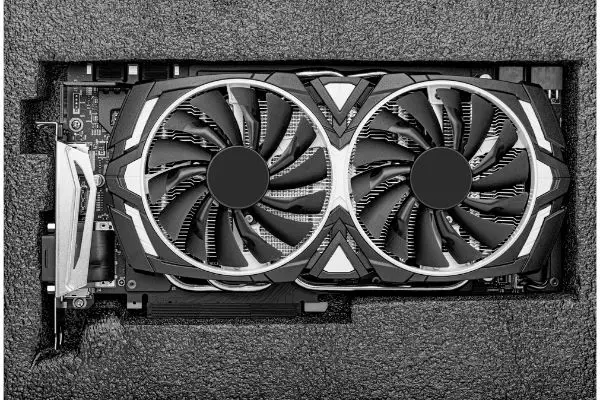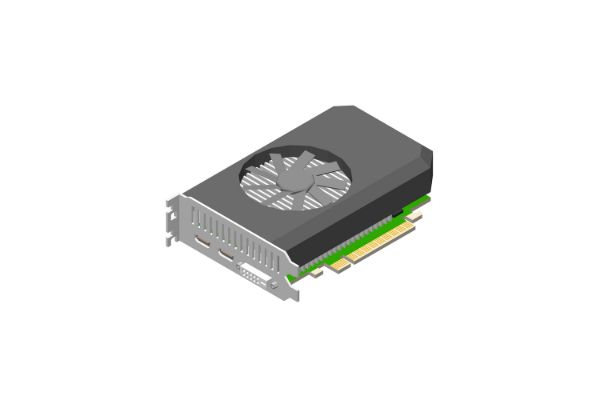Disclaimer: This post may contain affiliate links, meaning we get a small commission if you make a purchase through our links, at no cost to you. For more information, please visit our Disclaimer Page.
Along with the central processor, your graphics processor is one of the most important parts of your computer system. The central processor is like a brain that sends and receives information, and it executes instructions to make sure that the operating system of a computer runs smoothly. In some ways, the graphics processing unit shows you some of those instructions in the forms of videos, images, textures, colors, and more.
As the name might suggest, your graphics processor is the primary component that is responsible for running anything to do with the visuals or display portions of your computer. It may interact with other hardware to do this job, but it is the main workhorse for gaming and other tasks. When it works hard, it has to find a way to cool down. Most GPU parts have at least one fan that works to help heat dissipate from the unit.
Some computer enthusiasts wonder if the number of fans a graphics processor has makes any difference at all. We will go deeper into this subject in today’s article. As we do, we’ll open discussions about whether more fans cool graphics processors faster, or if they just add more air unnecessarily.
Once we get down to it, we’ll figure out if the single-fan model has any noticeable differences in performance from its counterparts that might use multiple fans, and how overclocking might affect a GPU with just one fan. To wrap things up, we’ll find out if there are ways for you to use a GPU with a broken fan safely, and we’ll try to put a number on how many fans you really need for your processor.
Table of Contents
Does the Number of Fans Matter on a GPU?
Yes, the number of fans on a graphics processor can be something important in its design. Although there aren’t many hard rules for this sort of thing, generally speaking, more fans are probably better on higher end graphics processors.
That is to say, processors that developers intend to run big, resource-intensive applications for long periods could get quite hot as they are working. More fans can help to offset this buildup of heat.
Having said that, it is also important to look at the whole design of the cooling system for the graphics processor. For example, fan size is also a factor. You may have multiple fans, but perhaps all of them are rather small. It could very well be that the same card could get better cooling service from a single large fan instead.
If you change the cooling system in some way, you may find that the card gets rid of heat better, and that is true even if you’re going with fewer fans. Additionally, the entire cooling system for the graphics processor may use more than just fans to get the job done.
The main thing to remember here relates to noise levels. A single-fan unit, on balance, will work harder and create more noise than some of its counterparts sporting multiple fans. Processors with single fans can still work quite well, but the noise level differences might be noticeable.
If you prefer your computer to run as quietly as possible, you may wish to consider getting a GPU that uses multiple fans to increase airflow. Each fan will help the others, and there would be less need for any single one of those fans to run loudly.
Will More Fans Cool the GPU?
More fans might cool the graphics processor, but this is not necessarily a given. It depends on your current setup, how the fans you already have are operating, to what temperatures your GPU might be getting already, and more.
It is a good idea to remember that your computer case itself should also have fans. The fans on a graphics processor are extra accessories to help keep it cool when it runs hot. However, good fan placement inside your case is essential to keeping all of the hardware cool, and this includes the GPU. With at least two intake fans and an exhaust fan, for example, you would have an ideal setup to make sure that airflow over all the parts of the computer is good, all things being equal.
Another thing to keep in mind is how manufacturers design graphics cards. For the most part, a competent manufacturer of cards like these will build them to tolerate high heat numbers. This does not necessarily mean that a graphics processor cannot benefit from at least one fan. However, it does mean that a good piece of hardware such as this should be able to tolerate getting hot and staying that way, at least for a while.
Quite high temperature tolerances are the norm for even slow graphics cards developers make in order to do light work. Some larger cards will get quite hot, too, but they usually come with better cooling systems to keep things in check.
Does a Single-Fan GPU Affect Performance?
Having only a single fan on your graphics processor won’t necessarily affect performance in any adverse way. Remember, it is still getting some cooling from the fans in the rest of the case. It is true that having more fans dedicated to cooling the graphics processor specifically could keep it cooler.
However, the difference in degrees that you get here would not be large. As such, it is not very likely that a single-fan GPU is going to make applications run slower or worse just because the hardware has only one fan.
What you would have to look at is how close the graphics processor is to operating at its full limit. Further, you would want to find out how long it stays at this upper limit while it is working with applications for you.
If your card operates at its full capacity for a long time, and it does so quite often, it is possible that having only one fan on it may not be enough to keep it cool. A processor working like this will generate a lot of heat, and one fan may have trouble siphoning such heat away when it is working alone.
Is It Safe To Overclock a Single-Fan GPU?
You might be able to overclock a GPU with only one fan. However, it depends on the settings you are working with, and you have to keep an eye on a few things.
If you’re able to do so, you may want to consider bringing the voltage on your single-fan unit down before you overclock it. Many graphics cards have voltage settings that are higher than what they might need when you get them brand new from stock. Although it may not be necessary to make this change with the voltage, it could help you when you want to overclock the card.
Furthermore, you’ll need to keep track of temperatures. You can use different kinds of software precisely for this purpose. In fact, much of the software you’ll find out there can run different diagnostics at once. You can also use programs like these to guard against possibly bricking the card itself.
There is a higher possibility that your system might crash during testing phases when you are trying to overclock. However, this sort of thing rarely results in damage to the graphics processor. Most of the worst scenarios are that you need to restart the system.
Before doing anything else, you can try lowering the overclock speeds by particular, regular increments. Doing this in the form of a pattern can help you find the overclock rate that is acceptable for whatever single-fan processor you are using.
Can You Use a GPU With a Broken Fan?
The answer to this question can depend on the rest of the setup of your cooling system in general. We also have to factor in what kind of fan you are using.
Depending on the layout of your case, and considering how many fans you might have to cool the whole case and everything in it, it may be possible to run a graphics processor with a broken fan. However, this comes with a caveat.
We assume here that the airflow in the case is sufficient to cool the graphics processor, and we further assume that the GPU never needed its own fan from the start.
The above is not necessarily true for many graphics cards on the market today. Many of the models you find will come with at least one dedicated fan that you should use to cool the GPU.
If your graphics card has a fan like this, you can be sure that the developers decided that it needed one in order to maintain normal operating temperatures.
In other words, if they could have manufactured the card in such a way that it didn’t need a fan for cooling, they would have done exactly this. GPU models with fans need them, speaking very generally.
We also have to determine what we mean by “broken” in this context. If you have a fan that works but one of the blades snapped off at some point, it may still offer sufficient cooling for the GPU. Uneven blades like this can cause spinning that leads to vibrations or extra noise.
However, if you are still getting good temperatures for the graphics processor when you run the fan, this version of a broken fan may still be fine to use with the device. You may be able to reattach the missing blade, but you would need to use a substance that can handle the spinning and temperatures inside without issue.
How Many GPU Fans Do I Need?
There are several factors that make this question somewhat ambiguous, and much of how we might recommend something here will depend on the individual. As we’ve noted, single-fan GPU parts can run quite well, they just tend to get louder or retain a bit more heat.
Most budget cards should do fine with only one fan. More powerful cards that work harder may need additional fans to get sufficient cooling. However, if you are using your computer in places with very cool ambient temperatures, any card may already get enough cooling with one fan. For hotter areas, you may wish to consider adding another.
Conclusion
Although this is a topic with somewhat less decisive answers than others, we can still make some educated guesses about GPU fans. Many of them work fine with one, but others need extra cooling. If your card comes with a particular number of fans, we recommend using all of them.
There are also programs you can use to keep track of temps. You can even overclock single-fan units, but make sure you have the right data beforehand.


